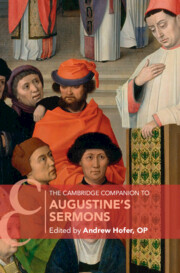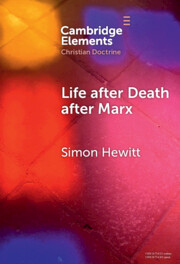Refine search
Actions for selected content:
34 results
Chapter 3 - Perfect Happiness
- from Part I - Aquinas on Individual Happiness
-
- Book:
- Aquinas and the Ethics of Happiness
- Published online:
- 07 August 2025
- Print publication:
- 21 August 2025, pp 60-96
-
- Chapter
- Export citation
16 - Preaching on Heaven and Its Peace
- from Part III - Augustine’s Preaching Themes
-
-
- Book:
- The Cambridge Companion to Augustine's Sermons
- Published online:
- 26 May 2025
- Print publication:
- 12 June 2025, pp 299-316
-
- Chapter
- Export citation

The Cambridge Companion to Augustine's Sermons
-
- Published online:
- 26 May 2025
- Print publication:
- 12 June 2025

Life after Death after Marx
-
- Published online:
- 18 March 2025
- Print publication:
- 17 April 2025
-
- Element
- Export citation
Chapter Seven - The Afterlife
- from Part II
-
- Book:
- Reforming Art in Renaissance Venice
- Published online:
- 24 January 2025
- Print publication:
- 13 February 2025, pp 324-361
-
- Chapter
- Export citation
4 - Second-Personal Worship
- from Part II - What Is Worship?
-
-
- Book:
- The Philosophy of Worship
- Published online:
- 09 January 2025
- Print publication:
- 23 January 2025, pp 51-69
-
- Chapter
- Export citation
Senses of οὐρανός, Hebrews 12.25–29, and the Destiny of the Cosmos
-
- Journal:
- New Testament Studies / Volume 71 / Issue 1 / January 2025
- Published online by Cambridge University Press:
- 07 August 2025, pp. 80-91
- Print publication:
- January 2025
-
- Article
- Export citation
1 - The Tradition of the Apotheosis in Early Spanish America
-
- Book:
- Fallen From Heaven
- Published online:
- 12 December 2024
- Print publication:
- 19 December 2024, pp 30-63
-
- Chapter
- Export citation
Utrum sit una tantum vera enumeratio virtutum moralium (Whether There Is a Single Correct List of the Virtues of Character)
-
- Journal:
- New Blackfriars / Volume 105 / Issue 5 / September 2024
- Published online by Cambridge University Press:
- 23 September 2024, pp. 471-477
- Print publication:
- September 2024
-
- Article
-
- You have access
- Open access
- HTML
- Export citation
Chapter 1 - Giving Up the Ghost
-
- Book:
- Disability, the Body, and Radical Intellectuals in the Literature of the Civil War and Reconstruction
- Published online:
- 13 June 2024
- Print publication:
- 04 July 2024, pp 31-70
-
- Chapter
- Export citation
Eschatological naturalism and ecological responsibility: Troubling some assumptions
-
- Journal:
- Scottish Journal of Theology / Volume 77 / Issue 3 / August 2024
- Published online by Cambridge University Press:
- 05 June 2024, pp. 245-259
- Print publication:
- August 2024
-
- Article
-
- You have access
- Open access
- HTML
- Export citation
Aquinas on the Fixity of the Will After Death
-
- Journal:
- New Blackfriars / Volume 104 / Issue 1114 / November 2023
- Published online by Cambridge University Press:
- 01 January 2024, pp. 651-667
- Print publication:
- November 2023
-
- Article
- Export citation
12 - The Fleshly Resurrection of the Saints
- from IV - The Resurrection of Human Flesh
-
- Book:
- Augustine's Theology of the Resurrection
- Published online:
- 21 April 2023
- Print publication:
- 30 March 2023, pp 215-240
-
- Chapter
- Export citation
I.1 - William Caxton, To Know Well To Die (1490)
- from Part I - Preparatory and Dying Arts
-
-
- Book:
- The Death Arts in Renaissance England
- Published online:
- 25 February 2023
- Print publication:
- 08 September 2022, pp 51-128
-
- Chapter
- Export citation
Chapter 5 - Narratives about the Panagia
-
- Book:
- The Virgin Mary in Byzantium, <i>c</i>.400–1000
- Published online:
- 20 August 2022
- Print publication:
- 08 September 2022, pp 179-210
-
- Chapter
-
- You have access
- Open access
- HTML
- Export citation
Chapter 5 - The Properties of Virtue
-
- Book:
- Thomas Aquinas on Virtue
- Published online:
- 09 June 2022
- Print publication:
- 23 June 2022, pp 158-190
-
- Chapter
- Export citation
Chapter 5 - Narratives about the Panagia
-
- Book:
- The Virgin Mary in Byzantium, c.400-1000
- Published online:
- 29 October 2021
- Print publication:
- 11 November 2021, pp 179-210
-
- Chapter
- Export citation
Chapter 13 - The Vision of Tnugdal
- from Part IV - Notable Authors and Texts
-
-
- Book:
- Imagining the Medieval Afterlife
- Published online:
- 07 December 2020
- Print publication:
- 17 December 2020, pp 247-263
-
- Chapter
- Export citation
Chapter 7 - Visions of the Otherworlds in the Late Middle Ages, c. 1300–c. 1500
- from Part I - Chronological Surveys
-
-
- Book:
- Imagining the Medieval Afterlife
- Published online:
- 07 December 2020
- Print publication:
- 17 December 2020, pp 115-130
-
- Chapter
- Export citation
Chapter 14 - The Afterlife in the Visionary Experiences of the Female Mystics
- from Part IV - Notable Authors and Texts
-
-
- Book:
- Imagining the Medieval Afterlife
- Published online:
- 07 December 2020
- Print publication:
- 17 December 2020, pp 264-285
-
- Chapter
- Export citation
